Abstract
Japanese agriculture is facing a decrease in agricultural workers. Mechanization, both to save time and reduce physical input, is essential to solving this issue. Recent worldwide progress in Internet-of-things technology has enabled the application of remote-controlled and unmanned machinery in agriculture. This study was conducted in the Gojo-Yoshino mountainous region in Nara, Japan, which is famous for its persimmon cultivation. The performance of newly introduced smart agricultural machinery was studied in the field by simulating cultivation work. The results showed that the remote-control weeder, speed sprayer, and remote-control mini crawler carrier saved 90%, 75%, and 5% of weeding, spraying, and harvesting times, respectively, when compared with conventional methods. Such time savings led to an 8% decrease in the total working time spent on persimmon cultivation. In addition, using the speed sprayer showed improvement in the fruit’s quality. Results of the power assist suits did not show a time-saving effect but showed a reduction of physical burden. These results suggest that the mechanization of persimmon cultivation is efficient and labor-saving, and satisfies the need for farmers. However, the high investment costs remain an issue in extending mechanization to the region.
1. Introduction
Japanese agriculture is currently facing difficulties due to a decline in farming population and available farmlands. This decline in the farming population stems from a decrease in the number of young workers, owing to the country’s declining birthrate and an increasing aging population. Additionally, there is a negative perception of farming, such as the physical burden involved, it being labor-intensive, and the lower earnings realized when compared with other industries. The population of farmers decreased from 4.14 million in 1995 to 2.1 million in 2015, of which 1.33 million were above the age of 65 years. During the same period, the agricultural land area decreased from 5.04 million ha to 4.37 million ha [1].
Meanwhile, the Japanese government is aiming to increase the export of high-quality agricultural products. Among them, fruits are believed to have the potential to expand into foreign markets, which consequently will stabilize the income of farmers.
For maintaining and increasing production, the mechanization of agricultural work should result in saving labor, improving safety levels, and helping to break away from the physical burden of cultivation. In the last decade, advanced machinery—in which artificial-intelligence (AI) and Internet-of-things (IoT) technologies are applied—has been developed, and has also been expected to accelerate automation and the labor-saving of agricultural production globally [2,3]. In Japan, the development of such advanced machinery has progressed mainly in unmanned ground vehicles, power-assisted suits for labor-saving in lifting work, and unmanned aerial vehicles such as drones for fertilization application and pest control [4]. Most of them are relatively expensive, costing more than USD 1000. For promoting the developed machinery, the Japanese government is now strongly encouraging smart farming in practice, by initiating various projects nationwide [5]. This study of one such project was carried out in the Gojo-Yoshino region of Nara Prefecture, famous for its persimmon cultivation. By introducing smart technologies, the project was aimed at stabilizing persimmon production with less labor input.
Persimmon fruits have been cultivated in Japan since ancient times. In the Gojo-Yoshino region, persimmon cultivation as a cash tree crop started in the 1920s. The region is in a rural mountainous area of the central part of Japan (see Figure 1a,b), with an annual average temperature of 14.5 °C and an annual average rainfall of 1454 mm [6]. In the 1970s, land reclamation for persimmon farming was accelerated in the mountains and steep terrain, and in 1974, the national Agricultural Land Development Project was initiated. Consequently, the Gojo-Yoshino region became the second-largest persimmon-fruit-producing region in the country. Persimmon fruits are cultivated in both greenhouses and open fields (see Figure 1d), and 80% of national greenhouse production comes from this region [7]. For stabilizing fruit production, irrigation water is provided by the Ichinoki Dam, shown in Figure 1c, which was constructed in 1997 by the national government. A total of 1817 ha of land was reclaimed for irrigating orchards, of which ~1600 ha is for persimmons consisting of ~400 farm households (average of 4.0 ha per household) [8]. Many of the farming plots are widely scattered in mountainous areas on steep slopes that limit efficient cultivation. As in many other parts of Japan, there are high expectations for the introduction of advanced farming technology to small holders to solve the problems of aging and the decreasing number of farmers, especially since persimmon cultivation takes place in steep fields that require intensive labor for pruning, bud thinning, fruit thinning, harvesting, fertilizing, irrigating, and weeding. Therefore, it is essential for farmers to apply IoT technology to farm management, e.g., automated irrigation, harvesting, and weeding. However, the applicability and the degree of effectiveness of these technologies in these steep persimmon cultivation areas is still in question.
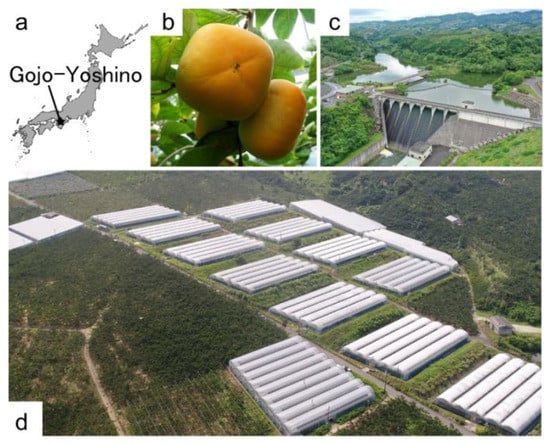
Figure 1.
Study area and view of persimmon cultivation. (a) Location of Gojo-Yoshino region; (b) Image of major persimmon grown in Gojo-Yoshino region, ‘Tone Wase’; (c) Ichinomi Dam for irrigation; and (d) Greenhouses and on-field persimmon cultivation areas.
High-quality production of Japanese fruits is based on its detailed management by farmers. Persimmon cultivation requires relatively less labor for the cultivation of fruit trees, but the annual working time per 100 m2 for persimmon cultivation is approximately seven times higher than that of paddy rice production (28 h 100 m2), which is 186 h per year [9,10]. To produce high-quality fruits, maintaining an intensive cultivation management is required throughout the year. Therefore, fruit farming tends to be in small-scale units with a limited labor force to manage the entire field. By contrast, fruit farming in the Gojo-Yoshino region is on a relatively large scale by Japanese standards, because the field layout was designed by a national government project, although the average size of the plot is ~200 m2. Therefore, it is desirable to mechanize cultivation to maintain high-quality production in small-scale fields in the mountainous areas of Japan, such as the selected area in this study, in order to improve work efficiency and save labor. In standard persimmon cultivation management, the time spent on harvesting is the longest, followed by bud/fruit thinning, pruning, and weeding/pesticide spraying, as shown in Figure 2.
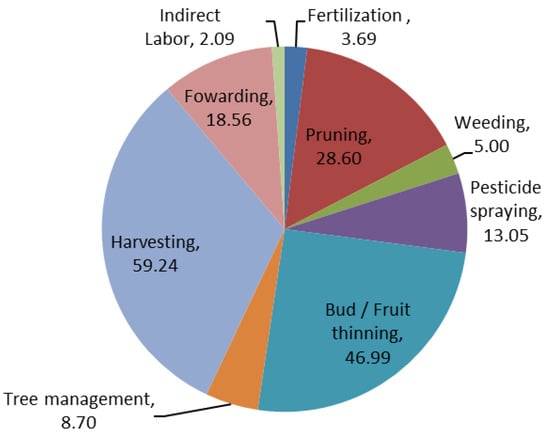
Figure 2.
Typical time spent on each work category of persimmon cultivation (rearranged from [9,10]).
The objective of this study was to assess the performance of newly introduced farm machinery under a mountainous setting for small holders. This paper describes a study on the performance assessment of labor-saving machinery for weeding, pest control, and harvesting in persimmon cultivation. The remote-control weeder, Speed Sprayer (SS), remote-control mini crawler carrier, and power assist suit that are available on the market were used for the field experiments. The machinery used in this study, which was introduced to the market in 2019, was the preference of the local farmers. Assessments were focused on the working time required for weeding, working time required and fruit quality during pest control, and working time and physical burden required for harvesting. The total labor-saving efficiency evaluated from these assessments can help understand the situation of smart farming in Japan and promote the introduction of smart farming machinery into on-site farm work.
2. Materials and Methods
Persimmon cultivation normally consists of pruning, bud thinning, fruit thinning, harvesting, and fertilization (Figure 3). Irrigation water is provided in rotation every eight days at 50 mm per application, from June to September.

Figure 3.
Management schedule of a single season of persimmon (‘Tone Wase’) cultivation based on the information provided by farmers in the Gojo-Yoshino region. Abbreviations are E: Early, M: Middle, and L: Late, Le: leafing, B: blooming, F: fertilization, P: pruning, BT: bud thinning, FT: fruit thinning, H: harvesting, PS: pesticide spraying, W: Weeding, and Ir: Irrigation.
The remote-control weeder (Sanyo Equipment AJK-600, Figure 4b), the Speed Sprayer (SS: Kioritz SSV665FSC, Figure 4d) for pest control, a remote-control mini crawler carrier (Sanko JS-800-CR, Figure 4f), and the power assist suit (Kubota WIN-1, Figure 4g) for harvesting, were used for experiments in the summer months of 2019 and 2020. Weeding performance of the weeder was compared with that of a two-stroke engine-powered hand-held brush cutter (Figure 4a). The SS was compared with a conventional engine-powered sprayer (Figure 4c). The performance of the remote-control mini crawler carrier was compared with a hand-pushed power-assisted mini crawler carrier (Figure 4e). The power assist suit was compared in its harvesting performance with a case without using the suit. All subjects provided their informed consent for inclusion before they participated in the study. The study was conducted in accordance with the Declaration of Helsinki, and the protocol used in the study was approved by the Ethics Committee of the Department of Agriculture, Kindai University (2019-8). Statistical analyses were applied to the data obtained from the experiments.
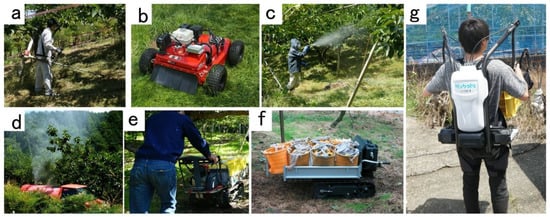
Figure 4.
Farm machinery used in the experiments: (a) hand-held brush cutter; (b) remote-control weeder; (c) conventional engine-powered sprayer; (d) speed sprayer; (e) hand-pushed power-assisted mini crawler carrier; (f) remote-control mini crawler carrier; and (g) power assist suit.
2.1. Remote-Control Weeder Experiment
The remote-control weeder used in the experiment is equipped with a hammer knife with a cutting width of 60 cm placed underneath the body (Figure 4b). It is driven by a gasoline engine with a maximum speed of 2.8 km h−1, and can operate on land with a maximum slope of 40 degrees. With the remote controller, the weeder can be operated from a maximum distance of 200 m. It has the flexibility to move forward and backward during its operation. The conventional hand-held brush cutter, which is widely used in the area, was used for the comparison. The brush cutter, with a two-cycle engine, rotates metal or nylon blades for cutting weed.
In the experiment, five test plots of 100 m2 each were selected in a persimmon field with an inclined slope of 17 degrees (Figure 5a). Weeding was carried out using the weeder and the brush cutter. The operating times were recorded from the beginning to the end of the work. The weeding rate, expressed as weeding area per minute, was calculated from the recorded time. The work time and the weeding rate were statistically compared between the 2019 brush cutter experiments and the 2019 and 2020 weeder experiments by Turkey HRD test.
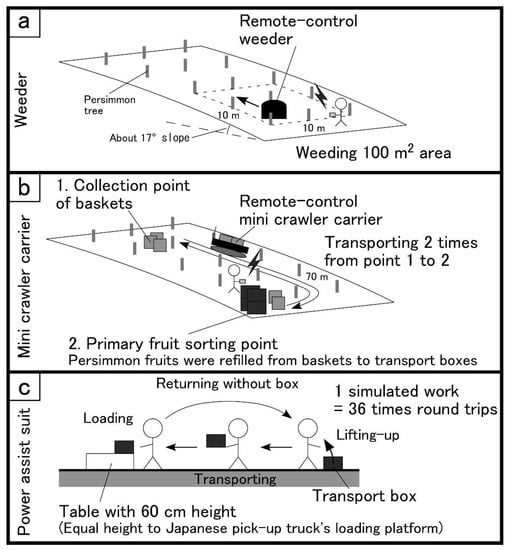
Figure 5.
Experimental settings adopted in persimmon cultivation: (a) experimental settings for weeder; (b) experimental settings for mini crawler carrier; (c) experimental settings for power assist suit.
Six adults participated as operators in the weeding experiment. The number of participating operators was different in each experiment due to limited time, as all of them were volunteers and participated in the experiments when it was convenient for them. The 2019 experiment was conducted in July. One of the six operators participated only in the brush cutter experiment and not in the weeder experiment. Four of the six operators were beginners at using the brush cutter, while the remaining two had experience. The five operators who participated in the weeder experiment were all beginners at using the weeder. The 2020 experiment was also conducted in July. The 2020 experiment focused only on the weeder. Two of the five 2019 weeder operators had a year’s experience in operating the weeder and participated again in the experiment to record the work times. One of the two operators conducted the experiment twice.
2.2. Speed Sprayer (SS) for Pest Control
The SS sprays the liquid chemicals from multiple nozzles, and the atomized chemical is sprayed by the blower over a wide area. The introduced SS has a closed cabin to protect the operator from exposure to chemicals, and the cabin is air-conditioned to ensure comfortable use during the hot summer.
When using the conventional sprayer, chemicals are sprayed from a nozzle by hand using the same pump as that mounted on the SS to match the pumping power with the SS. The conventional sprayer requires at least two assistants to pull out the hose and operate the pump. In addition, the operator and assistant each need to wear a pair of raincoats, masks, and goggles to avoid chemical exposure. The experimental field was divided into two: one area where the SS could enter (2776 m2) without being obstructed by orchard trees and branches, and another area where the SS could not enter (224 m2). The working times and the amount of chemicals used in each field were recorded. The chemical application rate expressed as the chemical amount sprayed per minute, the work rate expressed as the area sprayed per minute, the amount of chemical application expressed as the amount of chemicals applied per minute, and operational times per 100 m2 were estimated. All the estimated values were statistically tested between the conventional sprayer and the SS by the Mann–Whitney test.
In addition, fruit quality was compared in the 2020 season between the two areas where the SS and the conventional sprayer were used. Considering that about 20 fruits were randomly harvested three times on 07/10/2020 from the two areas, resulting in 60 fruits from each area, a total of 120 fruits were examined. The harvested fruits were sorted into three grades by a skilled farmer. The first grade fruits and the second grade ones were both sellable, but the second grade fruits had more scratches or were less colored than the first grade fruits. The third grade fruits were damaged and unsellable, as they had many scratches or excessive mature coloring. All the results were changed to percentages for the 20 fruits and were statistically tested by the Turkey HSD test.
2.3. Remote-Control Mini Crawler Carrier
The remote-control mini crawler carrier is a battery-powered caterpillar-type vehicle that can be operated for two hours on a single battery charge, and it is operated from a maximum distance of 200 m. The conventional practice of persimmon harvesting is that the fruits are manually placed in a basket, and when six to eight baskets are full, they are carried to the primary fruit-sorting point by the carrier. Because the remote-control carrier can be operated from a distance, the physical burden on farmers can be reduced when working on such sloped fields. The experiment was carried out by simulating the work using two transport boxes (520 mm × 370 mm × 300 mm) weighing 20 kg, which were loaded onto the carrier instead of using the basket (as is the conventional practice), and then moved between the primary sorting point and the collection point of the harvest basket. As a vehicle of transport, a remote-control mini crawler carrier and a hand-pushed power-assisted mini crawler carrier (Figure 4e), which are widely used in the area, were used for comparison. The work time required for the round trip of fruit carrying were monitored. The carriers made two round trips between a distance of 70 m of the two points (Figure 5b). The operators were four adults who had no experience in operating either type of carrier. The experiment was carried out after practicing the operation on a flat field for 10 to 20 min and after a sufficient break. The recorded times were analyzed separately in uphill and downhill situations, and then tested by the Turkey HSD test.
2.4. Power Assist Suit
The power assist suit used in this study is battery-driven and can lift a load 100 times with a single charge. The attached waist servo motor has a maximum assist force of 77 Nm, and the winch, which is a characterized feature of this model, has a maximum suspension assist force of 20 kgf. In the case of persimmon transportation generally, the box can be held only by the winch of the power assist suit. At the time of harvest, the transport boxes are transported to the truck bed parked at a side road of the field, and a truck can carry 36 transport boxes at a time. In addition, the same number of transport boxes are loaded and unloaded at the fruit sorting plant. It is expected that the power assist suit can reduce the physical burden of such work and shorten the working time. As shown in Figure 5c, the simulated task imitated the work of stacking the fruit transport boxes onto the truck bed and moving the transport boxes weighing 20 kg each onto a table of 60 cm height, which was placed 5 m away from the starting point. The round trip was repeated 36 times. Times of each participant for one round trip were compared by ANOVA. The experiment was conducted in 2020, and the 15 participating operators consisted of 12 males and 3 females. Three of these males performed the experimental tasks thrice to examine changes in the working time due to their proficiency in operation. Results of the proficiency tests were statistically analyzed by the Turkey HSD test.
The average time of round trips (Ta) was calculated for each participant using Equation (1). The parameter Ti is the time spent for the i-th round trip of the participant, and n is the total number of round trips. The time spent for each round trip, expressed as TNi, was normalized using Equation (2); n was 36 for male participants and 24 for female participants. These equations were modified from the methods used by Oka and Kishimoto [11]. TNi with or without the suits were compared by the Mann–Whitney test.
Physical burden was assessed by adopting the method proposed by Kato and Okubo [12]. The participants in the experiments self-evaluated the fatigue experienced in each of their body parts before and after the experiment by filling out a questionnaire. They identified the fatigued part and the change in the degree of fatigue between the cases with and those without using the power assist suit. In the questionnaire, the whole body was categorized into 60 parts, and the degree of fatigue was recorded at four levels of each part: 1. less tense; 2. no change; 3. slightly tense; 4. tense; and 5. very tense. The results with and without the suit were compared by the Mann–Whitney test.
3. Results
3.1. Comparison of the Working Time with Remote-Control Weeder
Table 1 sets out the results of the experiment in working times, weeding rates of the remote-control weeder, and the brush cutter. None of the five remote-control weeder operators had any experience in weeder operation prior to the 2019 experiment. These operators and one additional operator participated in the experiment with the brush cutter. Among them, two operators had experience using the brush cutter. Comparing the averages, using the remote-control weeder resulted in a speed that was 2.8 times faster than when using the brush cutter. The result of the experience with the remote-control weeder showed a significant increase in the work speed, as shown in Table 1. In the 2020 experiment, the difference in working speed increased to 9.2 times, and the speed was 3.3 times faster than the speed in 2019. As a result, the weeding time per unit area under the remote-control weeder reduced to 10.2% of that with the brush cutter.

Table 1.
Work time and weeding rate in the weeding experiment.
3.2. Assessment of Speed Sprayer (SS)
As shown in Table 2, the working speed of operating the SS was 3.5 times faster on average compared to using the conventional engine-powered sprayer, and the work time per unit area was reduced by 75%. The average amount of chemicals sprayed per unit time was 3.8 times larger but the spraying efficiency, as expressed by the amount of chemicals sprayed per unit area, was nearly identical.

Table 2.
Performance of conventional and speed sprayers.
The time-saving effect, as shown in Table 3, reveals the efficiency achieved in the work. The amount of used chemicals is almost the same for both the SS and the conventional sprayer, but the variation in the spraying efficiency of the conventional sprayer is significant. Since the spraying efficiency is considered the amount of spraying per unit area, this result represents an uneven spraying. In addition to the reduction in the working time, using the SS resulted in more uniform chemical spraying.

Table 3.
Work time using different types of mini crawler carriers.
In the quality of the harvested fruits, there was significant difference between the 1st-grade rate in the SS area, the 2nd-grade rate in the conventional sprayer area, and the damaged-grade rate in the SS area, as shown in Figure 6. The damaged-grade fruits were significantly decreased in the SS area. In the conventional sprayer area, there was no significant difference among all the grades of the harvested fruits. However, by using the SS, the most abundant grade seemed to move from the 2nd grade to the 1st grade. These trends indicate that using the SS was more profitable in terms of the quality of the harvested fruits than using the conventional sprayer.
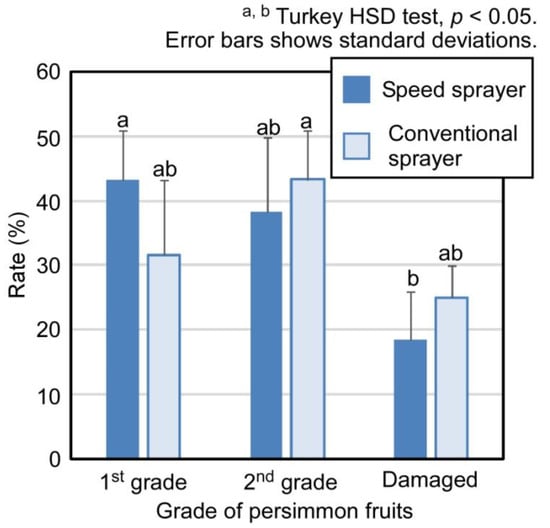
Figure 6.
Quality change in persimmon fruits when using the Speed Sprayer (SS) and conventional sprayer.
3.3. Comparison of the Working Time with Remote-Control Mini Crawler Carrier
Table 3 shows a comparison of the average times required for moving the remote-control mini crawler carrier and the hand-pushed power-assisted mini crawler carrier. The time required for the uphill movement with the hand-push type was significantly faster than the time for its downhill movement. However, when using the remote-control mini crawler carrier, there was no time difference between the uphill and downhill movements. Although no statistically significant differences were found, the average time required for the remote-control type was slower than that for the push-type in the uphill movement, and faster than that for the downhill movement. The average time required for one round trip was 13.2 s, which is a 5% reduction in the average time.
The harvesting work of the remote-control mini crawler carrier consists of several processes, such as harvesting, transportation, and fruit selection. Since transportation does not occupy a large proportion of the harvesting work, the time-saving effect with the remote-control mini crawler carrier was expected to be 5% or less when considering the entire harvesting work.
3.4. Power Assist Suit
Table 4 shows the results of the experiment where the participants used the power assist suit for the first time. The table shows the average time required for one round trip of the job. When female participants used the power assist suit, they made 36 round trips in transporting the transport box, and when they did not use the power assist suit they made 24 round trips. When the power assist suit was first used, the time required for all the male and female participants was higher by an average of about 1.5 times.

Table 4.
Average time for one round trip at the first use of the power assist suit.
Figure 7 shows the average TNi for all participants with/without using the power assist suit versus each number of round trips. The results showed that the time required when using the power assist suit increased significantly in the first and second round trips compared to when not using the suit. Conversely, from the 15th to 19th round trips, the time required without using the suit tended to increase compared to when using the suit, and it especially increased significantly in the 18th round trip. After the 19th round trip, there were no significant differences between the two.
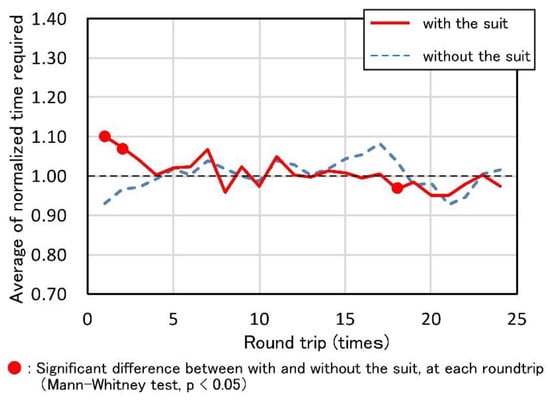
Figure 7.
Change in the average of normalized time (TNi) for participants of the power assist suit experiment.
Figure 8 shows the changes in the average time required for one round trip in the first to the fourth set of 36 round trips by three male participants using the power assist suit. As the number of the round trip sets increased, the participants spent less time on it due to being accustomed to the operation of the power assist suit. There was no significant difference in the times between the first and second sets, but the time was significantly shortened as the number of round trip sets increased. In particular, the required time for the fourth set was almost the same as the time without using the suit.
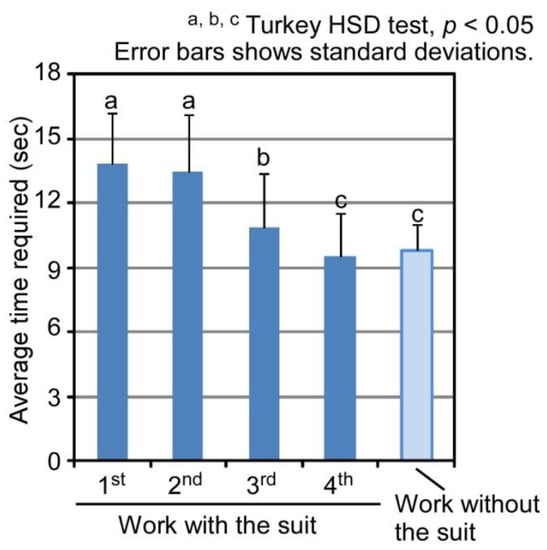
Figure 8.
Average time required for each of the 32 round trips of the first to the fourth repeated work.
Physical conditions were recorded by the participants themselves after completing the simulated work using the power assist suit. The red and blue shaded body parts in Figure 9 show the parts in which the physical burden significantly changed after using the power assist suit. The burdens on the palm and arm were significantly reduced, while the burden on the thighs increased. The power assist suit is known to reduce the load on the lower back [13], but this was not recognized by the participants.

Figure 9.
Change in physical burden on body parts after using the power assist suit.
The results of the experiment showed that the power assist suit can be useful for continuous load carrying, although it may not lead to a reduction in working time.
4. Discussion
4.1. Weeding Work
Conventional weeding work is usually performed using a brush cutter, but it is very risky because of the possibility of injury from exposure to rotating blades and health hazards caused by the vibration [14,15]. The diameter of the brush cutter’s blade is ~20 cm, and the working space can be limited depending on the size of the blade. By contrast, the riding mower, which is a riding-type self-propelled weeder widely used in the study area, has the risk of falling on steep-sloping fields [16], although it provides a faster work speed and less physical burden compared to the brush cutter. The remote-control weeder potentially reduces the risk of accidents, since it can be operated from a distance.
The results of this experiment showed that the remote-control weeder increased the speed of weeding by approximately nine times, and the work time per unit area was reduced to 1/10 (see Table 1). As mentioned previously, the average land plot in the Gojo-Yoshino area is 200 m2, which means the work time per plot is about 8 h (470 min) when using a brush cutter compared to 47 min when using a remote-control weeder. A brush cutter is often operated by two or three people simultaneously, which takes about 3 h per field. The remote-control weeder needs only one operator. Using the weeder reduces not only the work time, but also the number of workers required for the weeding. The reduction in the labor employed—and, probably, the employment cost of weeding—can be significant through using the remote-control weeder.
4.2. Pest Control Work
A high-quality persimmon fruit is regarded as one with no scratches and good coloring on the surface. Pest control is indispensable for producing high-quality fruits, and in the Gojo-Yoshino region it is recommended to spray pesticide six to eight times during March to October. Farmers need to finish the pest control of all the fruit trees within 10 days (Figure 3), and it must be performed in fine weather conditions to ensure the adhesion of pesticides. The risk of missing the spray time during the optimum control period is always a concern for farmers, especially during the rainy seasons of June, July, and September. The SS can reduce the working time per unit area by 75%, as shown in Table 3. Assuming a conventional sprayer is used on a total of 4.0 ha as the average land holding of persimmon orchards in the region, it takes at least four days to complete the spraying of all plots with 8 h of work per day. When adding the time to deploy and wind the hose, and the time to move between the plots, pest control takes a week to complete. When the SS is used, the pest control work can be completed within 8 h. This time reduction via the SS is advantageous to avoid missing the optimum control period.
Pesticide control using the SS can also contribute to maintaining high fruit quality because it enables timely pest control and uniform spray, in addition to saving working time. This was revealed by the rate of 1st-grade fruits increasing significantly from the damaged grade when using the SS, although the rates of all the grades were almost the same when using the conventional sprayer (Figure 6). Usage of the SS can lead to improvement of the farmer’s income by increasing the production of high-grade fruits.
4.3. Harvesting
Harvesting work is the most time-consuming in persimmon cultivation (Figure 2). In this study, we examined two machines: a remote-control mini crawler carrier and a power assist suit used for the harvesting. The remote-control mini crawler carrier showed a 5% reduction in work time (Table 2); the power assist suit did not show any reduction in work time, even when the participants had become accustomed to its operation (Figure 8).
In current cultivation practices in the Gojo-Yoshino region, most harvesting work is carried out manually, using harvesting scissors for cutting the fruits from the trees and placing them in a basket, which is time consuming. At present, automation in persimmon harvest is limited, due to difficulties in cutting the fruits from trees with various shapes and the different maturing conditions for each fruit in the field, unlike the developed auto-harvesting machines for apple cultivation [17]. Since the transportation work is not a time-consuming work in the whole harvesting process, the time-saving effect of mechanization is not significant. For example, in the orchard where the experiment was conducted, the harvest in 2020 was carried out by five people for 8 h a day, and the total working time for the harvesting was 40 h. The transportation took 100 min a day using the hand-push-type power-assisted mini crawler carrier (one round trip takes about 4 min per 25 round trips). Since the time reduction effect of using the remote-control mini crawler carrier was 5%, the transportation time was reduced to 95 min or less than 1% of the total harvesting work time. Since the remote-control mini crawler carrier can be operated from a distance, it is not necessary for the operator to follow the carrier on the slope, which results in a reduction of the physical burden.
The advantage of using the power assist suit lies in reducing the physical burden of transporting, stacking, and loading and unloading the 20 kg transport boxes. The power assist suit is originally known for supporting the load on the movement of the waist when lifting a heavy object, and is mainly used in the fields of nursing and social welfare work [13,18]. Previous studies applied to agricultural work have reported a reduction in the strain on the lower back muscles [19] and a decrease in heart rate [20]. The effect of reducing the burden may lead to a reduction in the work time of continuous work in the 15th to 18th round trips (Figure 7). Since the simulated work in this study was completed in a short time, within 8 to 11 min, the data did not show a reduction in the total work time. When the transportation work takes longer to complete, the time-saving effect may be observed.
The power assist suit used in this study is equipped with an attachment for lifting the transport box and a winch to help hold it in its lifted state. The results of this study showed the effect of this equipment, as the load on the upper arms and hands was reduced (Figure 9). However, it is inevitable that the winch will increase the workspace, turning the branches of the fruit trees into obstacles and restricting the movement of the worker. For future use, it is desirable that the size of the winch-holding device be miniaturized while maintaining the current assisted capability. In addition, since the power assist suit used in this study weighs 10 kg, a total load of 30 kg may cause fatigue during long-time work.
4.4. Mechanization of Persimmon Cultivation
As previously mentioned, persimmon cultivation management requires much labor for weeding, pest control, and harvesting (Figure 2). The expected post-mechanization work times for the weeding, pest control, and harvesting were 0.50 h/100 m2 (−4.5 h), 3.26 h/100 m2 (−9.79 h), and 58.65 h/100 m2 (−0.59 h), respectively, or shortened by 14.88 h/100 m2 compared with the conventional work, which accounts for 8% of the total working time (185.92 h/100 m2, Figure 2). For a farmer who owns an average of 4 ha land in the Gojo-Yoshino region, the annual reduction time will be 595 h. This time reduction can lead to a decrease in labor costs for farmers when used to reduce the number of farm personnel. The effect of reducing labor costs may, however, become relatively small, because many farms in the Gojo-Yoshino area are family-owned, and the farmers tend not to employ workers. However, when farmers recognize the reduction time as surplus and utilize this surplus time for other types of work, mechanization can generate more income for farmers. Moreover, as revealed from analyzing the use of the SS, mechanization can lead to improved fruit quality and increased profitability. Therefore, the expected results of introducing smart farming [2,3], i.e., labor saving and income increment, can certainly be achieved in Japanese persimmon cultivation.
However, only 8% of the total working time for persimmon management was reduced by the 2019 machinery that was introduced. Many of the other harvesting processes have remained manual, and the proportion of working hours for harvesting is still the longest among all the cultivation work. In addition, the technology that enables mechanization of bud and fruit thinning, as well as pruning work, has not yet been developed for persimmon cultivation. The mechanization of these types of work will result in significant time reduction and an increase in the efficiency of the entire management of persimmon cultivation.
4.5. Mechanization Obstacles and Its Solutions
Investment costs remain the issue, as the cost of the machines used in this research is more than USD 1000 per unit. In particular, limited uses of the remote-control mini crawler carrier and the power assist suit in harvesting work may result in very little effect on the reduction in either labor saving or labor cost. The high costs are enough to offset the merit of mechanization. To reduce the initial cost, adapting the machinery to suitable work is essential, considering the characteristics of the work under specified locally dependent situations. The remote-control weeder and the SS in this study were recognized as good such examples of suitable adaptation. However, sharing machines among farmers may be an option to reduce the initial investment cost for individual farm households. In the Gojo-Yoshino region, there are organizations such as the agricultural cooperative and production associations for shipping persimmons, and the land improvement district for the management of irrigation. These organizations have close relationships with farmers, and can take the initiative for sharing such machinery. Persimmon cultivation consists of various management processes, which have their characteristic behaviors and require unique machines such as those introduced in this study. In order to mechanize all of the management processes of persimmon cultivation as much as possible, one possible solution will be the sharing of the management-specialized smart machines by the locally rooted organization.
5. Conclusions
This study examined the agricultural machines currently available in Japan for persimmon cultivation in mountainous areas. The results showed significant time saving when the remote-control weeder and the speed sprayer were used; the remote-control mini crawler carrier and the power assist suit did not show any remarkable reduction in work time. However, the remote-control carrier and the power assist suit could effectively reduce the physical burden. All the simulated works in this study were completed in a short period, within 1 h. Further research is needed to assess the effect of the agricultural machines in longer-period works. Moreover, potential improvements in the quality of the fruits observed in the speed sprayer assessment may increase revenue. Thus, although the mechanization of persimmon cultivation has advantages, the high initial cost of investment remains an issue to be addressed to facilitate its widespread use in farming.
Newly developed machines for smart farming are being released to the market one after another. It will be important to clarify the specific characteristics required in the works for mechanization and to assess the economic validity for the introduction of advanced machines in the cultivation practice.
Author Contributions
Conceptualization, A.Y., Y.M. and M.K.; methodology, A.Y. and Y.M.; validation, Y.M., M.K. and T.K.; formal analysis, A.Y.; investigation, A.Y. and Y.M.; resources, Y.M. and M.K.; data curation, A.Y. and T.K.; writing—original draft preparation, A.Y.; writing—review and editing, Y.M. and M.K; visualization, A.Y. and T.K.; supervision, Y.M.; project administration, Y.M. and A.Y.; funding acquisition, Y.M. and M.K. All authors have read and agreed to the published version of the manuscript.
Funding
This research was funded from 2019 to 2021 by the National Agriculture and Food Research Organization (NARO) under the project entitled “Smart Agricultural Development and Demonstration Project (Ka-F05)” and “Technological Development Project for Strengthening International Competitiveness (Mo-7-Ka-1)”.
Institutional Review Board Statement
The study was conducted in accordance with the Declaration of Helsinki, and approved by the Ethics committee of the Department of Agriculture, Kindai University (2019-8, 3 April 2020).
Informed Consent Statement
Informed consent was obtained from all subjects involved in the study.
Data Availability Statement
The data that support the findings of this study are available from the corresponding author upon reasonable request.
Acknowledgments
The authors express deep gratitude to Katsuhiko Yaginuma, Kiyoshi Hiraoka, and Koji Ishikawa of NARO for their guidance during the project. The authors also acknowledge Kinki Administration Bureau of the Ministry of Agriculture, Forestry, and Fisheries of Japan; Nara Prefectural Government; Gojo Yoshino Land Improvement District; Keisuke Asada, Yoshiki Yamazaki, Jyunpei Tsumura, and Daisuke Sakamoto for their support to the project.
Conflicts of Interest
The authors declare no conflict of interest.
References
- Japanese Ministry of Agriculture, Forestry and Fisheries. Census of Agriculture and Forestry 2015. Available online: https://www.maff.go.jp/e/data/stat/index.html (accessed on 7 September 2021).
- Moysiadis, V.; Sarigiannidis, P.; Vitsas, V.; Khelifi, A. Smart farming in Europe. Comp. Sci. Rev. 2021, 39, 100345. [Google Scholar] [CrossRef]
- Pivoto, D.; Waquil, P.D.; Talamini, E.; Finocchio, C.P.S.; Dalla Corte, V.F.; de Vargas Mores, G. Scientific development of smart farming technologies and their application in Brazil. Inf. Process. Agric. 2018, 5, 21–32. [Google Scholar] [CrossRef]
- Japanese Ministry of Agriculture, Forestry and Fisheries. New Agricultural Technology, Products and Services. Available online: https://www.maff.go.jp/j/kanbo/smart/attach/pdf/products-62.pdf (accessed on 7 September 2021). (In Japanese)
- Yasuoka, S. Promotion of “smart agriculture”. J. Robot. Soc. Jpn. 2017, 35, 362–365. (In Japanese) [Google Scholar] [CrossRef][Green Version]
- Previous Weather Data Searching Page of Japan Meteorological Agency. Available online: https://www.data.jma.go.jp/obd/stats/etrn/index.php (accessed on 7 September 2021). (In Japanese)
- JA Naraken. The secret of "House Persimmon" in Nishi-Yoshino-cho, Gojo City. Mahoroba JA Mag. 2020, 253, 12–13. Available online: https://www.ja-naraken.or.jp/magazine/pdf/202008.pdf (accessed on 7 September 2021). (In Japanese).
- Gojo-Yoshino Land Improvement District. Leaflet of Gojo-Yoshino Land Improvement District; Gojo-Yoshino Land Improvement District: Nara, Japan, 2002. (In Japanese) [Google Scholar]
- Japanese Ministry of Agriculture, Forestry and Fisheries. Management Statistics by Crop 3–8 Persimmon 2007. Available online: https://www.maff.go.jp/j/tokei/kouhyou/noukei/hinmoku/ (accessed on 7 September 2021). (In Japanese)
- Nara Prefecture. Fruit Tree Agriculture Promotion Plan in Nara Prefecture 2011. Available online: http://www.pref.nara.jp/secure/122121/narakenkajusinnkoukeikaku.pdf (accessed on 7 September 2021). (In Japanese).
- Oka, H.; Kishimoto, H. Muscle fatigue estimation by electrostimulus threshold. Biomechanism 1998, 14, 119–128. (In Japanese) [Google Scholar] [CrossRef][Green Version]
- Kato, Z.; Okubo, T. How to Measure Biological Function for Beginners, 1st ed.; Japan Publication Service: Tokyo, Japan, 1999. (In Japanese) [Google Scholar]
- Sato, Y.; Jiaou, H.E.; Kobayashi, H.; Muramatsu, Y.; Hashimoto, T.; Kobayashi, H. Development and Quantitative Performance Estimation of the Back Support Muscle Suit. Trans. Jpn. Soc. Mech. Eng. C 2012, 78, 2987–2999. (In Japanese) [Google Scholar] [CrossRef]
- Work Safety Points of the Hand-Held Brush Cutter in the Homepage of Agricultural Notice for Zero-Accident Engineering. Available online: https://www.naro.affrc.go.jp/org/brain/anzenweb/point/point_htm/point_htm_bru.htm (accessed on 7 September 2021). (In Japanese).
- Kashima, J.; Uemura, T. Analysis of accidents related to brush−cutter use. J. Jpn. For. Eng. Soc. 2010, 25, 77–84. (In Japanese) [Google Scholar]
- Hamming, B.; Childers, E.; Jones, C. Injuries associated with the use of riding mowers in the United States, 2002–2007. J. Saf. Res. 2009, 40, 371–375. [Google Scholar] [CrossRef] [PubMed]
- Mazzia, V.; Khaliq, A.; Salvetti, F.; Chiaberge, M. Real-time apple detection system using embedded system with hardwear accelerators: An edge AI application. IEEE Access 2020, 8, 9102–9114. [Google Scholar] [CrossRef]
- Jin, S.; Xiong, X.; Zhao, D.; Jin, C.; Yamamoto, M. Long-term effects of a soft robotic suit on gait characteristics in healthy elderly persons. Appl. Sci. 2019, 9, 1957. [Google Scholar] [CrossRef]
- Nagano Agricultural Experiment Station. Agricultural Technology to Spread 1 2017. Available online: https://www.agries-nagano.jp/wp/wp-content/uploads/2018/06/2017-1-g01.pdf (accessed on 7 September 2021). (In Japanese).
- Wakayama Fruit Tree Research Station. Effect of Reducing the Work Load of the Assist Suit. Available online: https://www.pref.wakayama.lg.jp/prefg/070100/070109/gaiyou/002/seikahappyou_d/fil/27suit.pdf (accessed on 7 September 2021). (In Japanese).
Publisher’s Note: MDPI stays neutral with regard to jurisdictional claims in published maps and institutional affiliations. |
© 2022 by the authors. Licensee MDPI, Basel, Switzerland. This article is an open access article distributed under the terms and conditions of the Creative Commons Attribution (CC BY) license (https://creativecommons.org/licenses/by/4.0/).